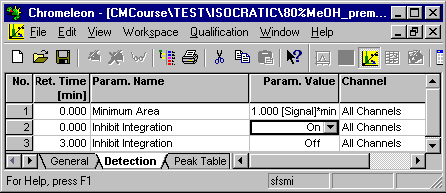The QNT Editor
![]() Detection Parameters (Detection)
Detection Parameters (Detection)
Detection parameters serve, for example, to recognize, classify, and suppress peaks as well as to determine the baseline.
The default values are normally suitable for optimum integration of 90% of all recorded chromatograms.
In critical cases (for example, with wavelength switching), the user can improve the integration results by modifying the parameters.
Detection parameters are time-dependent. At a specific time, each parameter can be enabled or disabled and/or its value can be changed. Enter the time at which the parameter changes, as well as the parameter name and value in the related column in the first line. It is possible to change a parameter several times in succession.
Detection parameters are defined in the QNT Editor. You can either enter them in the table of the Detection tab page or define them graphically in the chromatogram.

In the example above, integration is inhibited (Inhibit Integration command) at the time t = 0.000 (On). After three minutes (t = 3.000), integration is enabled again (Off). It is also stipulated that peaks with a minimum area of 1 x [Signal] *min only are recognized as peaks.
The last defined value of each parameter is valid until the sample run is completed. After that, the parameters assume their preset (default) values.
If a parameter value changes at a specified time, this is referred to as event. You can have Chromeleon list these events in the report at the time of the change with a short description and the numerical value.
You are not required to enter the events in chronological order. Chromeleon sorts them in ascending order before saving them.
The meaning of the parameter table columns is as follows:
|
No. |
Line number: The number is read-only. |
|
Ret. Time [min] |
Retention time in minutes. The allowed range is 0.000 - 999.999 minutes. |
|
Param. Name |
Parameter name: The dialog box lists all available parameters. To open the dialog box, press the F8 key or double-click the column. |
|
Param. Value |
Parameter value: The dialog box provides exact information about which values are allowed for the selected parameter. |
|
Channel |
Channel: Click the arrow or press the F8 to open the dialog box and select an option, i.e., either All Channels or one of the recorded channels. |
Usually, the chromatogram and the report table are immediately updated when the detection parameters have been changed. However, you may disable this function by deselecting Autom. Re-Integerate on the View menu of the QNT Editor. If this option is disabled, save either the QNT Method or select Start Integration on the View menu to start re-integration with the new integration parameters.
![]() Tip:
Tip:
The setting for this option is saved in the corresponding Report Definition File.
For more information and examples, refer to Integrating Chromatograms and Identifying Peaks ![]() Defining Detection Parameters and Detection Parameters (Overview).
Defining Detection Parameters and Detection Parameters (Overview).
In many cases, it is easier to define the detection parameters graphically in the chromatogram. For more information, refer to Working with Chromatograms ![]() Defining Detection Parameters Graphically.
Defining Detection Parameters Graphically.